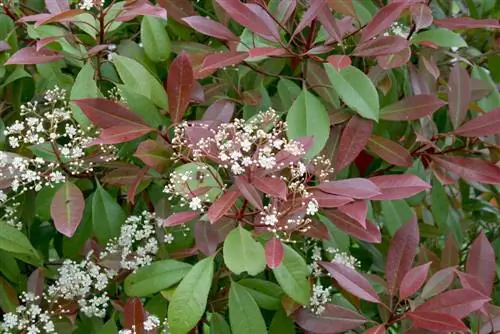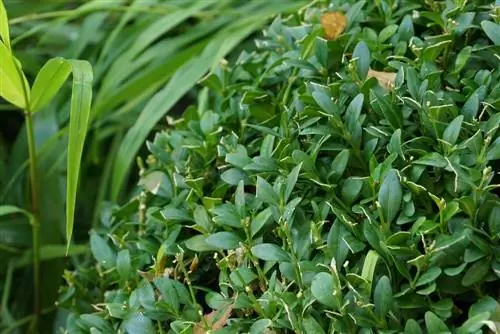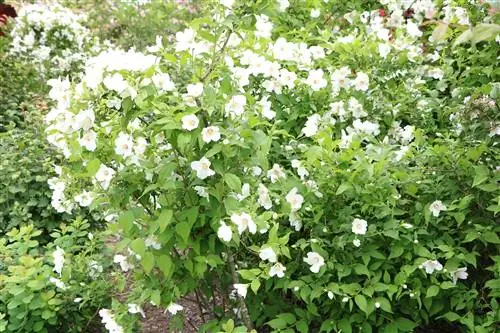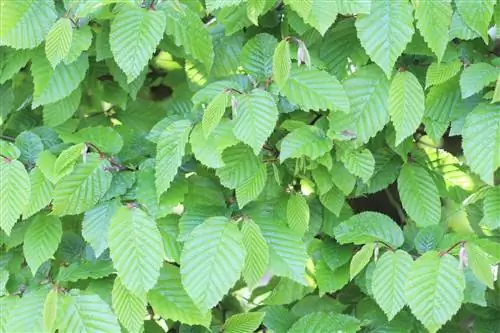- Author admin [email protected].
- Public 2023-12-17 03:39.
- Last modified 2025-01-24 12:45.
Plants such as cherry laurel, thuja or boxwood are popular hedge plants in this country. However, they have one disadvantage for households with small children: they are poisonous. Anyone looking for non-toxic hedge plants that are also evergreen and fast-growing will soon realize that solving this task is not as easy as you think. Nevertheless, you don't have to despair, because these plants exist.
Bamboo
Bamboo is a subfamily of sweet grasses (Poacae). There are approximately 116 genera within the subfamily. The fast-growing, evergreen species include the genera with the species:
Fargesia
The bamboo genus Fargesia includes around 90 species. The individual varieties do not form runners. Another feature is that these bamboos die after flowering. But don't worry, they only bloom every 80 to 100 years.
Fargesia murielae (garden bamboo)
- Varieties: “Jumbo”, “Simba”, “Superjumbo”, “Standing Stone”, “Smaragd”, “Maasai”
- Location: sun to shade (depending on variety)
- Soil: depending on variety
- Growth height: 200 to 350 centimeters (depending on the variety)
- Growth width: 75 to 250 centimeters (depending on the variety)
- Growth rate: 20 to 50 centimeters per year (depending on the variety)
- Growth: bushy, overhanging, umbrella-shaped or upright (depending on the variety)
- Leaves: delicate green to medium green (depending on the variety), elongated, lanceolate, pointed (depending on the variety)
- Special features: very good winter hardiness
Fargesia nitida “Jiuzhaigo 1”
- Botanical name: Fargesia nitida “Jiuzhaigo 1”
- Synonyms: Red Bamboo, Red Culm Bamboo
- Location: Sun to shade
- Soil: nutrient-rich, permeable, no waterlogging
- Growth height: 300 to 400 centimeters
- Growth width: 250 to 400 centimeters
- Growth rate: 40 to 80 centimeters per year
- Growth: upright, dense, well branched
- Leaves: narrow, delicate
- Winter hardiness: minus 18 to 28 degrees Celsius
- Special features: 2005 “Bamboo of the Year”, red stalk sheaths
Umbrella bamboo “Campbell”
- botanical name: Fargesia robusta “Campbell”
- Location: partial shade
- Soil: rich in humus, moist, sandy, well drained
- Growth height: 350 to 500 centimeters
- Growth width: 80 to 150 centimeters
- Growth rate: 20 to 45 centimeters per year
- Growth: upright, older plants overhanging
- Leaves: dark green with bluish underside, elongated
- Winter hardiness: down to minus 18 Celsius
- Special features: young shoots need frost protection, light scent
Umbrella Bamboo
- Botanical name: Fargesia rufa
- Synonyms: Sun-resistant garden bamboo
- Location: Sun to partial shade
- Soil: rich in humus
- Growth height: 200 to 300 centimeters
- Growth width: 150 to 250 centimeters
- Growth rate: 40 to 50 centimeters per year
- Growth: upright to cascade-like, overhanging, dense
- Leaves: elongated, intense green
- Winter hardiness: minus 24 degrees Celsius; protect from winter winds
- Special features: very easy to cut, therefore ideal for low and medium-high hedges
Bamboo “Asian Wonder”
- Botanical name: Fargesia scabrida “Asian Wonder”
- Location: Sun to partial shade
- Soil: normal garden soil, slightly acidic
- Growth height: 300 to 400 centimeters
- Growth width: 40 to 100 centimeters
- Growth rate: 10 to 50 centimeters per year
- Growth: upright, well branched
- Leaves: bluish-green, lanceolate, shiny narrow
- Winter hardiness: down to minus 26 degrees Celsius
- Special features: purple stalks, play of colors, robust, undemanding

Phyllostachys
In contrast to the Fargesia species, the representatives of this genus do not die after flowering. However, they form runners, so a root barrier is absolutely necessary for some varieties.
Black Bamboo
- Botanical name: Phyllostachys nigra
- Location: Sun to partial shade
- Soil: deep, permeable
- Growth height: 300 to 500 centimeters
- Growth width: 200 to 350 centimeters
- Growth rate: 20 to 50 centimeters per year
- Growth: loosely upright
- Leaves: lanceolate, very thin (papery); Upper side dark green, underside grey-green
- Winter hardiness: good winter hardiness
- Root barrier: recommended
- Special features: black stalks; forms comparatively few runners
Pseudosasa
The genus Pseudosasa includes around 36 species. Since all representatives of this species form runners, a root barrier is recommended.
Japanese Arrow Bamboo
- Botanical name: Pseudosasa japonicus, Arundinaria japonica
- Synonyms: Marmora Metake, Medake Arundinaria
- Location: partial shade to sun
- Soil: humus, permeable, also acidic
- Growth height: 300 to 500 centimeters
- Growth width: 100 to 200 centimeters
- Growth rate: 20 to 40 centimeters per year
- Growth: upright and overhanging
- Leaves: large, green; yellow when sprouting
- Winter hardiness: minus 18 to minus 20 degrees Celsius
- Root barrier: necessary
- Special features: protect against cold easterly winds, sprouts again after above-ground forest damage
Canadian Hemlock

- Botanical name: Tsuga canadensis
- Location: Sun to partial shade
- Soil: nutrient-rich, otherwise no further requirements
- Growth height: 1,500 to 2,000 centimeters
- Growth width: 600 to 1,200 centimeters
- Growth rate: 15 to 30 centimeters per year
- Growth: overhanging, umbrella-shaped or upright
- Leaves: green, needle-like
- Special features: frost hardy, tolerates cutting well
Tip:
The Pillow Hemlock, bot. Tsuga canadensis “Nana” is the small relative of the Canadian hemlock, but it only grows three to five centimeters per year.
Kapuka
- Botanical name: Griselinia littoralis
- Synonym: New Zealand leaves, papauma
- Location: Sun
- Soil: permeable, nutrient-rich
- Growth height: 150 to 500 centimeters (depending on the variety)
- Growth width: 75 to 250 centimeters (depending on the variety)
- Growth rate: 30 centimeters per year (depending on the variety)
- Growth: upright
- Leaves: green, shiny
- Flower: small, green-yellow
- Special features: only conditionally hardy (minus 5 to minus 10 degrees Celsius), windproof, ideal for coastal regions
Cotoneaster
Cotoneaster “Pink Crispy”
- Botanical name: Photinia fraseri “Pink Crispy”
- Location: Sun to partial shade
- Soil: permeable, fresh, moist, humus
- Growth height: 150 to 200 centimeters
- Growth width: 80 to 100 centimeters
- Growth rate: 15 to 20 centimeters per year
- Growth: bushy, upright, dense, well branched
- Flower: medium-sized, simple, panicle-shaped, red bud, white-pink flower from April to May
- Leaves: green-white variegated
- Special features: hardy, pink leaf shoots
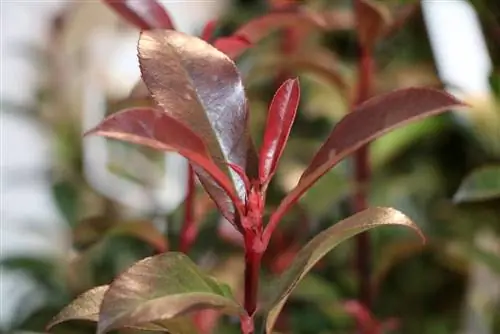
Red loquat “Red Robin”
- Botanical name: Photinia fraseri “Red Robin”
- Location: Sun to shade
- Soil: lime-free, warm, humic, loamy, deep
- Growth height: 150 to 300 centimeters
- Growth width: 120 to 200 centimeters
- Growth rate: 20 to 50 centimeters per year (depending on the variety)
- Growth: upright to broadly bushy
- Flowers: medium-sized, white flowers from May to June
- Leaves: red when sprouting, later green
- Special features: partially hardy, fruits not suitable for consumption
sack flower “Victoria”
- botanical name: Ceanothus impressus “Victoria”
- Location: Sun to partial shade
- Soil: normal garden soil
- Growth height: 80 to 100 centimeters
- Growth width: 50 to 70 centimeters
- Growth rate: 10 to 40 centimeters per year (depending on the variety)
- Growth: bushy, branched
- Flowers: small, deep blue, panicle-shaped flowers from the end of May to July
- Leaves: dark green, elliptical
- Special features: robust, hardy
Spruce
Alcock's Spruce
- Botanical name: Picea bicolor
- Location: Sun to partial shade
- Soil: permeable, fresh to moist
- Growth height: 1,000 to 1,500 centimeters
- Growth width: 300 to 700 centimeters
- Growth rate: 10 to 30 centimeters per year
- Growth: upright, narrow
- Leaves: two-tone needles, top dark green, bottom blue-silver,
- Special features: decorative cones
Blue Norway Spruce
- Botanical name: Picea pungens var. glauca
- Synonym: Blue Spruce
- Location: Sun
- Soil: no special requirements
- Growth height: 1,500 to 2,000 centimeters
- Growth width: 600 to 800 centimeters
- Growth rate: 15 to 30 centimeters per year
- Growth: upright, straight
- Leaves: blue, two to three centimeter long needles
- Special features: can be used as a Christmas tree
Blue spruce “Blue Mountain”
- Botanical name: Picea pungens
- Location: Sun to partial shade
- Soil: nutrient-rich, fresh, sandy, loamy
- Growth height: 1,500 to 2,000 centimeters
- Growth width: 600 to 800 centimeters
- Growth rate: 20 to 40 centimeters per year
- Growth: upright, conical crown
- Leaves: blue, piercing needles
- Special features: Cones only available for ages 30+

Chinese spruce
- Botanical name: Picea likiangensis var. rubescens
- Location: Sun to partial shade
- Soil: prefers moist, fresh, sandy soils, otherwise undemanding
- Growth height: 1,000 to 1,500 centimeters
- Growth width: 300 to 600 centimeters
- Growth rate: 10 to 30 centimeters per year
- Growth: upright, pyramidal, well branched
- Leaves: dark green-blue, short, pointed needles
- Special features: cone decorations, decorative needles
Serbian spruce
- Botanical name: Picea omorika
- Location: Sun
- Soil: permeable, not compacted, water tolerant
- Growth height: 1,500 to 3,000 centimeters
- Growth width: 250 to 400 centimeters
- Growth rate: 20 to 35 centimeters per year
- Growth: compact, dense, narrow
- Leaves: dark green, piercing needles; 8 to 18 millimeters long
- Special features: frost hardy, hanging cones, insensitive to diseases, easy to care for
Weeping hanging spruce “Inversa”
- Botanical name: Picea abies “Inversa”
- Location: Sun to partial shade
- Soil: sandy-loamy, fresh to moist
- Growth height: 600 to 800 centimeters
- Growth width: 200 to 250 centimeters
- Growth rate: 10 to 15 centimeters per year
- Growth: narrow, columnar
- Leaves: needle-like, green
- Special features: good leaf he alth
Orange flower “Aztec Pearl”
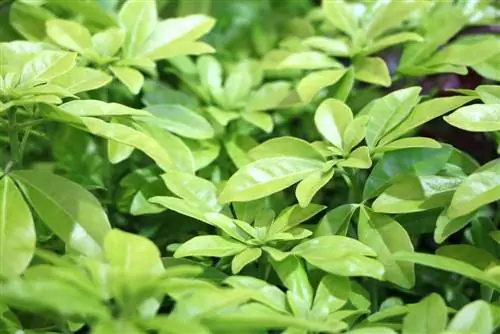
- Botanical name: Choisya ternata “Aztec Pearl”
- Location: Sun to partial shade
- Soil: permeable, acidic, nutrient-rich
- Growth height: 100 to 150 centimeters (depending on the variety)
- Growth width: 60 to 100 centimeters
- Growth rate: 10 to 20 centimeters per year
- Growth: compact, well branched
- Flower: small, simple, pink buds; Strongly fragrant, white flowers from May to June
- Leaves: medium green, long, narrow
- Special features: conditionally hardy, fragrant foliage, rebloom

